Modeling to Engineering and Failure Times Data: Using the Marshall–Olkin Extended Exponential Distribution
Abstract
In this article, we study and introduce the Marshall–Olkin extended exponential (MO-ExE) distribution, a novel three-parameter life expectancy distribution. The new model is characterized by high adaptability in data analysis. Various mathematical properties, including ordinary moments, moment-generating functions (MGFs), and conditional moments (CMs) of the new suggested model, were computed. The model parameters are estimated using the maximum likelihood method. A simulation study is evaluated to demonstrate the behavior of the parameter model. In the final analysis, we demonstrate the significance of the novel model by examining practical data applications, thus, showing the adaptability and potential of the MO-ExE model.
1. Introduction
Numerous authors have been inspired to produce more flexible and broad variations of the exponential distribution by its simplicity, memoryless characteristic, and constant hazard rate. These extended forms may be equivalent to actual data sets that demonstrate decreasing, growing, bathtub, decreasing-increasing, and unimodal failure rates. These failure rates are common in a variety of relevant disciplines, including engineering, medical, and reliability. Several notable extended forms of the exponential model are referred to as Harris ExE [5], sine generalized linear exponential [6], transmuted generalized exponential [7], type II Topp–Leone inverse length biased exponential [8], alpha power exponential [9, 10], unit ExE [11], Kumaraswamy transmuted exponential [12], Kavya–Manoharan generalized exponential [13], modified exponential [14], half logistic modified Kies exponential [15], Marshall–Olkin (MO) logistic exponential [16], Kavya–Manoharan inverse length biased exponential [17], Burr-X EE [18], Kavya–Manoharan Kumaraswamy exponential [19], and MO alpha power exponential [20]. For more information see [21–24].
Several authors have recently applied their methodology to extend the known distribution areas. Ghitany et al. [26] presented MO extended Weibull distribution, Saboor and Pogány [27] proposed MO gamma-Weibull distribution, Krishna et al. [28] studied the MO Fréchet distribution, Cordeiro and Lemonte [29] investigated the MO extended Weibull distribution, Cordeiro et al. [30] provided the MO family of distributions, Alabdulhadi et al. [31] studied some statistical inference of MO-ExE distribution, Alsadat et al. [32] proposed MO Weibull–Burr XII distribution, Okorie et al. [33] discussed MO generalized Erlang-truncated exponential distribution, MirMostafaee et al. [34] studied MO extended generalized Rayleigh distribution, Afify et al. [35] presented the MO additive Weibull distribution, Gilliarose and Tomy [36] introduced MO extended power Lomax distribution, Nwezza and Ugwuowo [37] proposed the MO Gumbel–Lomax distribution, Afify et al. [38] studied MO odd Burr III-G family of distributions, Elbatal and Elgarhy [39] discussed extended MO length-biased exponential distribution, and Haq et al. [40] proposed MO power Lomax distribution, among others.
- •
The MO-ExE distribution gives more flexibility than some well-known statistical models for engineering and failure times data as we illustrate in Section 6.
- •
The MO-ExE distribution is highly adaptable and includes three submodels.
- •
The shapes of the PDF for the MO-ExE distribution can be decreasing, right skewness, and unimodal. However, its HRF can be decreasing or increasing.
- •
Various statistical and mathematical features of the MO-ExE distribution are computed.
- •
The parameters of the MO-ExE distribution are estimated utilizing maximum likelihood approach.
The remainder of the paper is structured as follows: The MO-ExE distribution and the proposed model’s plots of the PDF and HRF are defined in Section 2. Section 3 discusses a number of mathematical features. We present the maximum likelihood estimates (MLEs) of the unknown parameters in Section 5. In Section 6, we ultimately demonstrate the significance of the new model by an examination of real-world data applications, illustrating its adaptability and potential, Finally, some concluding remarks are presented in Section 7.
2. The MO-ExE Distribution
- 1.
The MO-ExE distribution leads to the ExE distribution when α = 1.
- 2.
The MO-ExE distribution leads to the ExE distribution when α = 1 and θ = 0.
- 3.
The MO-ExE distribution leads to the MO-exponential distribution when θ = 0.
Figure 1 displays the PDF plots of the MO-ExE distribution for specific parameter values ϕ = (α, θ, λ), demonstrating that the proposed model’s PDF is positively skewed, unimodal, and monotonically decreasing.
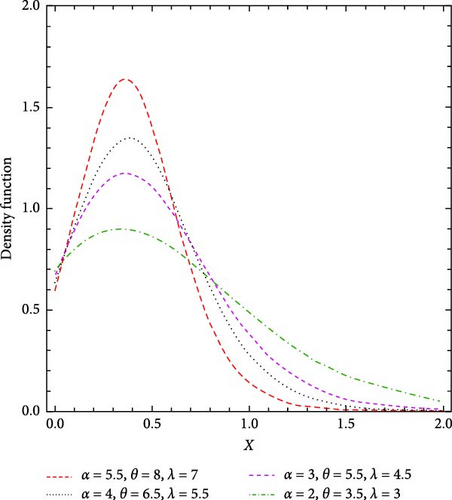
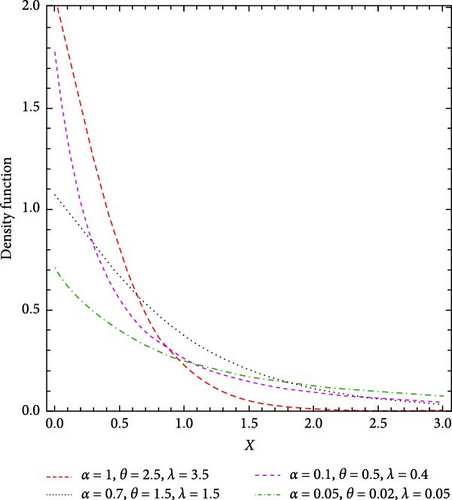
Figure 2 shows the HRF patterns corresponding to different distribution parameter values. The HRF of the MO-ExE distribution can be increasing or decreasing.
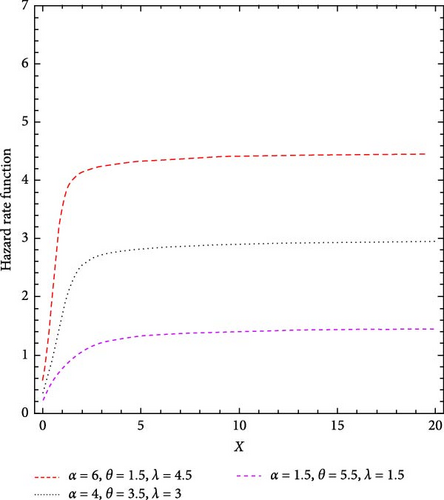
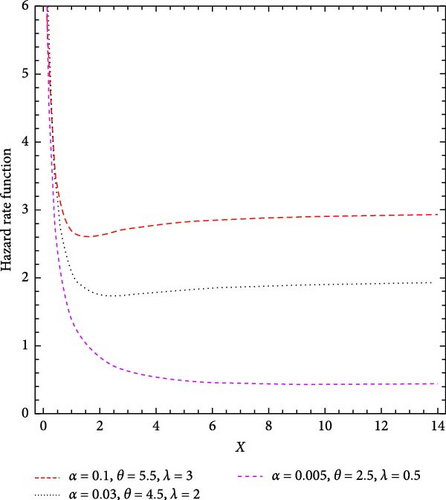
2.1. Useful Expansion for the PDF
3. Statistical Properties
This section examines the fundamental distributional characteristics of the MO-ExE model, including moments, moment-generating functions (MGFs), conditional moments (CMs), mean deviation, and the Lorenz and Bonferroni curves, as well as residual and inverted residual life functions.
3.1. Ordinary Moments
- •
First moment: Mean is the average value of a distribution, representing the central point of all data.
- •
Second moment: Variance measures the dispersion of data points from the mean, indicating the spread of values.
- •
Third moment: Skewness reflects the distribution’s asymmetry. A positive skew denotes a longer right tail, while a negative skew indicates a longer left tail.
- •
Fourth moment: Kurtosis [τ2 = (μ4 − 4μ μ3 + 6μ2μ2 − 3μ4)/σ4] describes the “peakedness” of a distribution. High kurtosis indicates a sharp peak, whereas low kurtosis suggests a flatter distribution.
In addition, the coefficient of variation [CV = σ/μ] quantifies the relative spread of data around the mean, analyzing these moments provides valuable insights into the shape and spread of the distribution, aiding informed decision-making based on the data.
Table 1 provides a comprehensive analysis of the first four moments of the MO-ExE distribution across various parameter values (λ, θ), maintaining a constant parameter value of α = 0.5. It is significant to note that higher parameter values are associated with a decrease in both the mean and variance. Conversely, skewness, kurtosis, and the coefficient of variation exhibit an increasing trend. Figure 3 provides a visual representation of these findings.
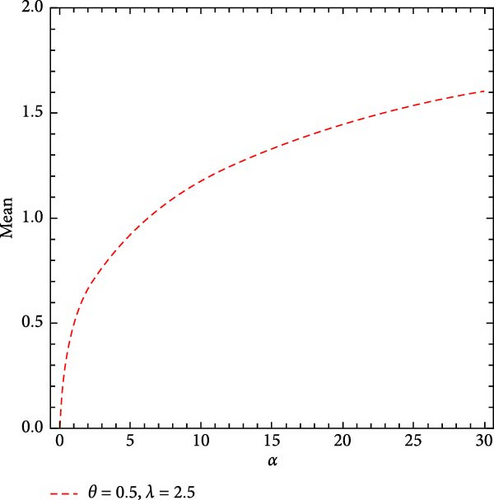
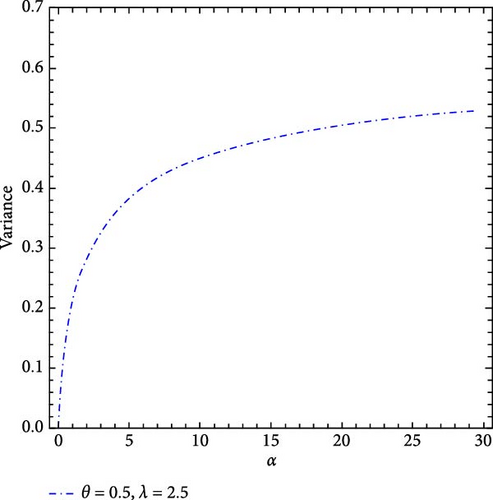
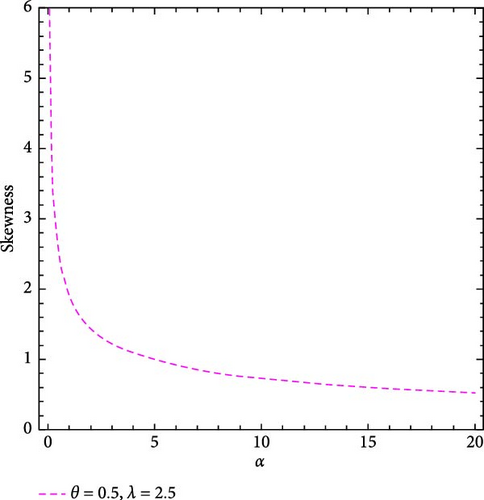
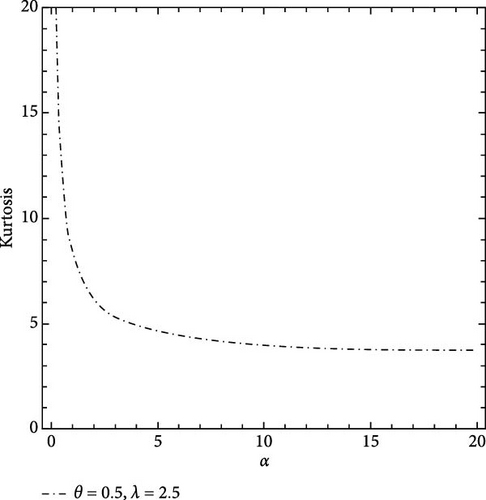
| θ | λ ↑ | ↓ | σ2 ↓ | τ1 ↑ | τ2 ↑ | CV ↑ | |||
|---|---|---|---|---|---|---|---|---|---|
| θ = 0.5 | 1 | 0.9373 | 1.9726 | 6.5292 | 29.2297 | 1.0940 | 2.2980 | 10.7225 | 1.1158 |
| 1.5 | 0.5825 | 0.7841 | 1.6849 | 4.9341 | 0.4449 | 2.3926 | 11.4155 | 1.1451 | |
| 2 | 0.4182 | 0.4104 | 0.6483 | 1.4028 | 0.2355 | 2.4482 | 11.8510 | 1.1604 | |
| 2.5 | 0.3247 | 0.2497 | 0.3107 | 0.5315 | 0.1442 | 2.4836 | 12.1410 | 1.1694 | |
| 3 | 0.2648 | 0.1670 | 0.1711 | 0.2415 | 0.0968 | 2.5075 | 12.3433 | 1.1751 | |
| 3.5 | 0.2233 | 0.1192 | 0.1036 | 0.1244 | 0.0693 | 2.5245 | 12.4898 | 1.1790 | |
| 4 | 0.1929 | 0.0892 | 0.0673 | 0.0702 | 0.0520 | 2.5369 | 12.5994 | 1.1817 | |
| θ = 1 | 1 | 1.0704 | 2.4026 | 8.2487 | 37.8334 | 1.2570 | 2.1189 | 9.5538 | 1.0475 |
| 1.5 | 0.6597 | 0.9522 | 2.1367 | 6.4503 | 0.5169 | 2.2238 | 10.2167 | 1.0898 | |
| 2 | 0.4687 | 0.4931 | 0.8162 | 1.8269 | 0.2735 | 2.2980 | 10.7225 | 1.1158 | |
| 2.5 | 0.3603 | 0.2965 | 0.3870 | 0.6860 | 0.1667 | 2.3521 | 11.1116 | 1.1331 | |
| 3 | 0.2912 | 0.1960 | 0.2106 | 0.3084 | 0.1112 | 2.3926 | 11.4155 | 1.1451 | |
| 3.5 | 0.2437 | 0.1384 | 0.1261 | 0.1571 | 0.0791 | 2.4237 | 11.6567 | 1.1538 | |
| 4 | 0.2091 | 0.1026 | 0.0810 | 0.0877 | 0.0589 | 2.4482 | 11.8510 | 1.1604 | |
| θ = 1.5 | 1 | 1.1541 | 2.6699 | 9.3036 | 43.0637 | 1.3380 | 2.0248 | 9.0094 | 1.0023 |
| 1.5 | 0.7136 | 1.0678 | 2.4441 | 7.4733 | 0.5587 | 2.1189 | 9.5538 | 1.0475 | |
| 2 | 0.5062 | 0.5540 | 0.9383 | 2.1331 | 0.2978 | 2.1930 | 10.0153 | 1.0781 | |
| 2.5 | 0.3879 | 0.3325 | 0.4451 | 0.8030 | 0.1820 | 2.2514 | 10.4007 | 1.0998 | |
| 3 | 0.3124 | 0.2192 | 0.2418 | 0.3609 | 0.1216 | 2.2980 | 10.7225 | 1.1158 | |
| 3.5 | 0.2605 | 0.1542 | 0.1444 | 0.1834 | 0.0863 | 2.3358 | 10.9927 | 1.1280 | |
| 4 | 0.2227 | 0.1138 | 0.0924 | 0.1021 | 0.0642 | 2.3668 | 11.2211 | 1.1376 | |
| θ = 2 | 1 | 1.2117 | 2.8523 | 10.0171 | 46.5801 | 1.3841 | 1.9694 | 8.7115 | 0.9710 |
| 1.5 | 0.7532 | 1.1524 | 2.6668 | 8.2102 | 0.5850 | 2.0505 | 9.1529 | 1.0155 | |
| 2 | 0.5352 | 0.6007 | 1.0311 | 2.3646 | 0.3142 | 2.1189 | 9.5538 | 1.0475 | |
| 2.5 | 0.4101 | 0.3612 | 0.4909 | 0.8947 | 0.1930 | 2.1761 | 9.9075 | 1.0714 | |
| 3 | 0.3299 | 0.2380 | 0.2671 | 0.4031 | 0.1292 | 2.2238 | 10.2167 | 1.0898 | |
| 3.5 | 0.2746 | 0.1673 | 0.1595 | 0.2051 | 0.0919 | 2.2640 | 10.4866 | 1.1042 | |
| 4 | 0.2343 | 0.1233 | 0.1020 | 0.1142 | 0.0684 | 2.2980 | 10.7225 | 1.1158 | |
| θ = 2.5 | 1 | 1.2537 | 2.9846 | 10.5319 | 49.1066 | 1.4128 | 1.9340 | 8.5302 | 0.9481 |
| 1.5 | 0.7837 | 1.2169 | 2.8356 | 8.7663 | 0.6027 | 2.0033 | 8.8917 | 0.9906 | |
| 2 | 0.5582 | 0.6376 | 1.1041 | 2.5458 | 0.3259 | 2.0651 | 9.2368 | 1.0227 | |
| 2.5 | 0.4281 | 0.3844 | 0.5279 | 0.9685 | 0.2011 | 2.1189 | 9.5538 | 1.0475 | |
| 3 | 0.3444 | 0.2537 | 0.2880 | 0.4379 | 0.1351 | 2.1655 | 9.8405 | 1.0671 | |
| 3.5 | 0.2865 | 0.1784 | 0.1722 | 0.2233 | 0.0963 | 2.2057 | 10.0981 | 1.0830 | |
| 4 | 0.2444 | 0.1314 | 0.1102 | 0.1245 | 0.0717 | 2.2407 | 10.3291 | 1.0960 | |
| θ = 3 | 1 | 1.2858 | 3.0850 | 10.9209 | 51.0098 | 1.4318 | 1.9099 | 8.4113 | 0.9307 |
| 1.5 | 0.8078 | 1.2677 | 2.9680 | 9.2010 | 0.6152 | 1.9694 | 8.7115 | 0.9710 | |
| 2 | 0.5770 | 0.6675 | 1.1630 | 2.6915 | 0.3345 | 2.0248 | 9.0094 | 1.0023 | |
| 2.5 | 0.4432 | 0.4037 | 0.5585 | 1.0292 | 0.2073 | 2.0747 | 9.2917 | 1.0272 | |
| 3 | 0.3568 | 0.2670 | 0.3055 | 0.4671 | 0.1397 | 2.1189 | 9.5538 | 1.0475 | |
| 3.5 | 0.2968 | 0.1879 | 0.1830 | 0.2388 | 0.0998 | 2.1582 | 9.7948 | 1.0641 | |
| 4 | 0.2531 | 0.1385 | 0.1173 | 0.1333 | 0.0744 | 2.1930 | 10.0153 | 1.0781 | |
3.2. MGF
The MGF serves as essential instruments in the fields of quality and reliability engineering, environmental sciences, and wireless communications, providing a robust mathematical framework for the analysis and interpretation of diverse datasets.
3.3. Incomplete Moments (IMOs)
Utilizing Equation (12), we obtain the mean . The value of is determined from Equation (7), whereas the first IMO () is calculated from Equation (14) with s = 1.
3.4. CMs
3.5. Mean Residual Life (MRL)
3.6. Mean Inactivity Time (MIT)
Table 2 illustrates the MRL and MIT of the MO-ExE distribution at t = 0.5, across a range of parameter values ϕ = (α, θ, λ), demonstrating that both functions display an increasing trend as the parameter values decrease. Furthermore, Figure 4 presents the distinct variations of MRL (on the right side) and MIT (on the left side).
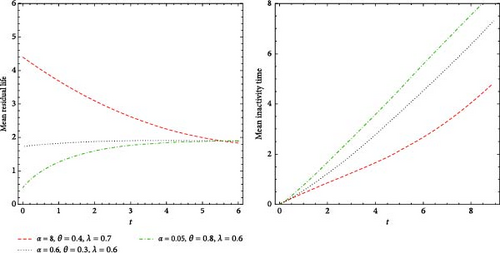
| α ↓ | θ ↓ | λ ↓ | MRL ↑ | MIT ↑ |
|---|---|---|---|---|
| 15 | 4 | 5 | 0.22415 | 0.76441 |
| 7 | 3.5 | 4 | 0.28844 | 0.78969 |
| 5 | 3 | 3.5 | 0.33552 | 0.80111 |
| 2.5 | 2.5 | 3 | 0.39255 | 0.88581 |
| 0.7 | 1 | 1.5 | 0.78272 | 0.94841 |
| 0.3 | 0.6 | 1 | 1.07806 | 1.06569 |
| 0.1 | 0.4 | 0.5 | 1.73405 | 1.11882 |
| 0.01 | 0.2 | 0.1 | 3.49257 | 1.15238 |
| 0.005 | 0.01 | 0.05 | 4.49875 | 1.28239 |
3.7. Moments of the Residual and Reversed Residual Life
4. Maximum Likelihood Estimation
The MLE of ϕ, say , is calculated by solving the nonlinear system Un(ϕ) = 0. Analytical methods are insufficient for deriving solutions to these equations; however, statistical software as Wolfram Mathematica can employ iterative techniques to obtain numerical solutions.
5. Simulation Study
Monte Carlo simulation is an advanced computational technique that employs random sampling to approximate solutions to intricate mathematical problems. By systematically sampling from a probability distribution to generate random data points, this method effectively estimates distribution parameters. It proves particularly valuable in scenarios where deriving an exact analytical solution is challenging or unfeasible. Consequently, Monte Carlo simulation is extensively utilized in various fields, including finance, physics, and beyond, to evaluate complex systems or models. This study will use this method to analyze the estimate behavior of the proposed model and apply MLE for parameter estimation. Simulations and result analyses were conducted using Wolfram Mathematica (13). The estimators for the MO-ExE distribution were assessed through the simulation of cases: Case (I): (α = 0.5, θ = 2, λ = 1), Case (II): (α = 3, θ = 2.5, λ = 1.5), and Case (III): (α = 0.25, θ = 1.75, λ = 0.75).
- •
Generate 1000 random samples of sizes 100, 150, 200, 250, 300, 400, 500, and 600 from the MO-ExE distribution by employing the inverse CDF method applied to uniformly distributed random variables, as described in Equation (7).
- •
Calculate the average of estimates from 1000 random samples using this relation:
-
- •
Determine the average bias (BIAS) and mean squared error (MSE) of the estimates using the formulas:
-
- •
In the simulations, MLE estimates generally overestimate, except for the parameter θ in cases (I and III), and the parameter λ in case (II), which are underestimated.
- •
The estimated values converge to the true values with an increasing sample size.
- •
As the sample size increases, the absolute values of BIAS and MSE for the MLE decrease.
- •
The MLE estimates’ BIAS and MSE approached zero as the sample size increases.
| Measures | n = 100 | n = 150 | n = 200 | n = 250 | n = 300 | n = 400 | n = 500 | n = 600 |
|---|---|---|---|---|---|---|---|---|
| α = 0.5 | 0.710152 | 0.668024 | 0.634878 | 0.630392 | 0.620537 | 0.602346 | 0.584785 | 0.573014 |
| BIAS | 0.210152 | 0.168024 | 0.134878 | 0.130392 | 0.120537 | 0.102346 | 0.084785 | 0.073014 |
| MSE | 0.217848 | 0.151064 | 0.118156 | 0.10487 | 0.096903 | 0.075671 | 0.059206 | 0.054452 |
| θ = 2 | 1.76559 | 1.79623 | 1.83413 | 1.83574 | 1.83667 | 1.86413 | 1.88333 | 1.90290 |
| BIAS | −0.23441 | −0.20377 | −0.16587 | −0.16426 | −0.16333 | −0.13587 | −0.11667 | −0.09710 |
| MSE | 1.27486 | 1.15673 | 1.04817 | 1.02471 | 0.992976 | 0.910952 | 0.805603 | 0.731323 |
| λ = 1 | 1.02536 | 1.01540 | 1.00889 | 1.00652 | 1.00658 | 1.00176 | 1.00143 | 1.000330 |
| BIAS | 0.025359 | 0.015402 | 0.008885 | 0.006518 | 0.006583 | 0.001763 | 0.001425 | 0.000330 |
| MSE | 0.051002 | 0.034367 | 0.0254 | 0.021492 | 0.017392 | 0.012844 | 0.010949 | 0.009074 |
| Measures | n = 100 | n = 150 | n = 200 | n = 250 | n = 300 | n = 400 | n = 500 | n = 600 |
|---|---|---|---|---|---|---|---|---|
| α = 3 | 3.81215 | 3.65019 | 3.64564 | 3.61889 | 3.57605 | 3.48971 | 3.48738 | 3.46129 |
| BIAS | 0.81215 | 0.65019 | 0.64564 | 0.61889 | 0.57605 | 0.48971 | 0.48738 | 0.46129 |
| MSE | 4.38468 | 3.11330 | 3.08591 | 2.61732 | 2.32387 | 1.86602 | 1.79911 | 1.65517 |
| θ = 2.5 | 2.67899 | 2.67407 | 2.60746 | 2.59439 | 2.59066 | 2.58359 | 2.52955 | 2.50680 |
| BIAS | 0.17899 | 0.17407 | 0.10746 | 0.09439 | 0.09066 | 0.08359 | 0.02955 | 0.00680 |
| MSE | 3.24638 | 3.01471 | 2.98248 | 2.93237 | 2.78912 | 2.62994 | 2.54434 | 2.41234 |
| λ = 1.5 | 1.47913 | 1.47948 | 1.48063 | 1.48229 | 1.48363 | 1.49407 | 1.49797 | 1.50053 |
| BIAS | −0.02087 | −0.02052 | −0.01937 | −0.01771 | −0.01637 | −0.00593 | −0.00203 | 0.00053 |
| MSE | 0.03679 | 0.02539 | 0.02029 | 0.01742 | 0.01424 | 0.01111 | 0.01006 | 0.00903 |
| Measures | n = 100 | n = 150 | n = 200 | n = 250 | n = 300 | n = 400 | n = 500 | n = 600 |
|---|---|---|---|---|---|---|---|---|
| α = 0.25 | 0.38548 | 0.354444 | 0.330359 | 0.325346 | 0.318486 | 0.308585 | 0.294194 | 0.286468 |
| BIAS | 0.13548 | 0.104444 | 0.080359 | 0.075346 | 0.068486 | 0.058585 | 0.044194 | 0.036468 |
| MSE | 0.089257 | 0.058665 | 0.044311 | 0.038475 | 0.03493 | 0.028308 | 0.020041 | 0.017383 |
| θ = 1.75 | 1.62622 | 1.65299 | 1.68664 | 1.69282 | 1.71127 | 1.72231 | 1.72544 | 1.73039 |
| BIAS | −0.12378 | −0.09701 | −0.06336 | −0.05718 | −0.03873 | −0.0276 | −0.024559 | −0.01961 |
| MSE | 1.17735 | 1.04847 | 0.918712 | 0.885921 | 0.839636 | 0.726631 | 0.626669 | 0.542414 |
| λ = 0.75 | 0.788679 | 0.776316 | 0.764728 | 0.764814 | 0.762897 | 0.757914 | 0.756756 | 0.753474 |
| BIAS | 0.038679 | 0.026316 | 0.014728 | 0.014814 | 0.012897 | 0.007914 | 0.006756 | 0.003474 |
| MSE | 0.052833 | 0.035097 | 0.026013 | 0.021996 | 0.018097 | 0.01309 | 0.011444 | 0.009546 |
6. Applications
In this section, two examples from real life data are given for showing the adaptability of the suggested model in use. Proschan [41] established the first set of data, consisting of 213 observations on the breakdown of air conditioning units in 13 Boeing 720 jet aircraft. Murthy et al. [42]stated a second data set that comprised the failure times of 20 components during an incident. For each set of data, we examine the resulting fit of the MO-ExE distribution to other comparable lifespan models; namely transmuted EE (TEE) by Merovci [43], modified Weibull (MW) by Sarhan and Mazen [44], ExE, EE, and Weibull (W) [45].
For both datasets we estimate model parameters by applying the MLE method. We also examine the information criteria indicators (ICIs) according to parameter estimates, namely, Akaike’s ICI (C1), Bayesian ICI (C2), and Hannan–Quinn ICI (C3). In addition, the Anderson-Darling (C4), Cramér-von Mises (C5), Kolmogorov-Smirnov (C6) tests, including their p-values (C7) have been employed to evaluate the MO-ExE distribution’s goodness of fit to other comparable models; this measurement (C6) evaluates the fit between the empirical and fitted distribution functions, making it an effective tool for determining how well a random sample’s distribution matches the theoretical distribution. Overall, the model with the lowest score on these measures and the greatest p-value for the C6 statistic is regarded as the most efficient.
Tables 6–11 present the estimated MLEs and goodness-of-fit metrics for both data sets across competitor models. These indicators imply that the MO-ExE distribution is more competitive compared to other models, providing the best fit among them.
| Model | Estimates | ||
|---|---|---|---|
| MO-ExE (α, θ, λ) | 6.469230 (6.194090) | 0.222574 (0.475727) | 0.471253 (0.123832) |
| TEE (ϑ, ρ, λ) | −0.68938 (0.260644) | 0.690760 (0.225134) | 0.188114 (0.051126) |
| MW (δ, β, λ) | 0.159586 (0.038955) | 0.069382 (0.067450) | 0.184692 (0.161200) |
| ExE (θ, λ) | 0.298136 (0.060561) | 0.701618 (0.787263) | — |
| EE (η, λ) | 0.157018 (0.046738) | 0.837733 (0.230045) | — |
| W (τ, λ) | 0.146923 (0.072181) | 1.08927 (0.220985) | — |
| Model | C1 | C2 | C3 |
|---|---|---|---|
| MO-ExE | 109.506 | 112.493 | 110.089 |
| TEE | 112.103 | 115.090 | 112.686 |
| MW | 111.663 | 114.650 | 112.246 |
| ExE | 110.901 | 112.892 | 111.289 |
| EE | 113.241 | 115.233 | 113.630 |
| W | 113.504 | 115.495 | 113.892 |
| Model | C4 | C5 | C6 | C7 |
|---|---|---|---|---|
| MO-ExE | 1.08841 | 0.079026 | 0.146940 | 0.780878 |
| TEE | 1.46429 | 0.231952 | 0.217339 | 0.301264 |
| MW | 1.64430 | 0.313950 | 0.238784 | 0.204206 |
| ExE | 1.33735 | 0.159410 | 0.187678 | 0.481686 |
| EE | 1.96265 | 0.343900 | 0.249319 | 0.166324 |
| W | 1.49001 | 0.157713 | 0.222019 | 0.277692 |
| Model | Estimates | ||
|---|---|---|---|
| MO-ExE (α, θ, λ) | 0.19557 (0.124275) | 0.0230811 (0.0166657) | 0.00854864 (0.00203448) |
| TEE (ϑ, ρ, λ) | 1.0151 (0.0833724) | 0.508941 (0.234288) | 0.0082095 (0.00148917) |
| MW (δ, β, λ) | 3.59276 × 10−7 (0.016259) | 0.015674 (0.017535) | 0.924550 (0.097428) |
| ExE (θ, λ) | 4.0143 × 10−6 (0.00132945) | 0.0107404 (0.00151768) | — |
| EE (η, λ) | 0.0102094 (0.000945646) | 0.926924 (0.0830183) | — |
| W (τ, λ) | 0.015674 (0.00391304) | 0.924552 (0.0481744) | — |
| Model | C1 | C2 | C3 |
|---|---|---|---|
| MO-ExE | 2356.76 | 2366.85 | 2360.84 |
| TEE | 2358.53 | 2368.62 | 2362.61 |
| MW | 2361.17 | 2371.25 | 2365.24 |
| ExE | 2361.53 | 2368.25 | 2364.25 |
| EE | 2360.80 | 2367.53 | 2363.52 |
| W | 2359.17 | 2365.89 | 2361.89 |
| Model | C4 | C5 | C6 | C7 |
|---|---|---|---|---|
| Mo-ExE | 0.360324 | 0.042783 | 0.038959 | 0.902942 |
| TEE | 0.650193 | 0.103808 | 0.044174 | 0.800182 |
| MW | 0.827545 | 0.127828 | 0.051952 | 0.613359 |
| ExE | 1.697890 | 0.324893 | 0.072620 | 0.211265 |
| EE | 1.201570 | 0.217023 | 0.064452 | 0.339115 |
| W | 12.66690 | 1.596710 | 0.124359 | 0.002753 |
Figures 5 and 6 show the log-likelihood profiles, demonstrating that the likelihood formulas have a distinctive solution in regards to the distribution parameters. Moreover, Figures 7 and 8 illustrate the data sets’ histograms with the fitted PDF, as well as the empirical and estimated SF plots, to determine the MO-ExE model’s appropriateness.
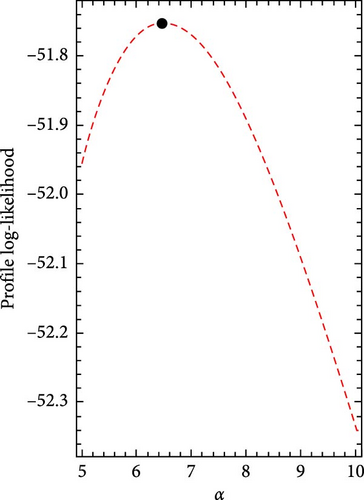
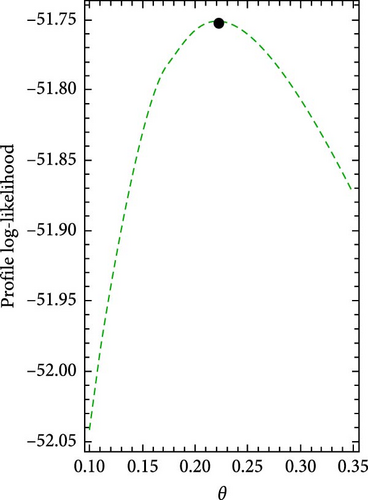
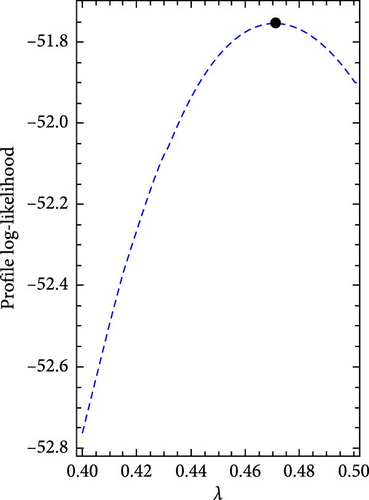

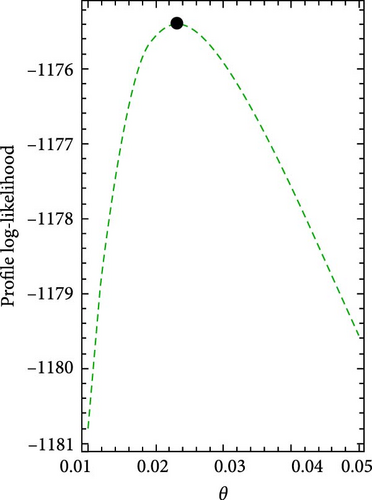

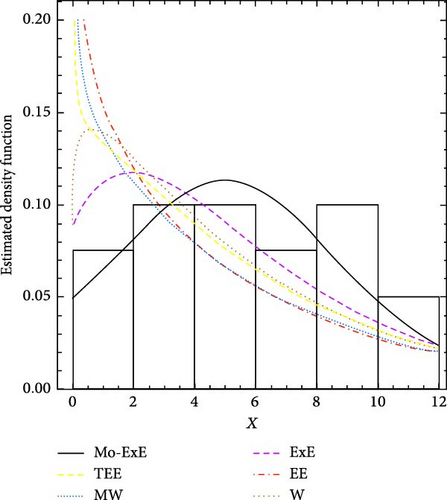
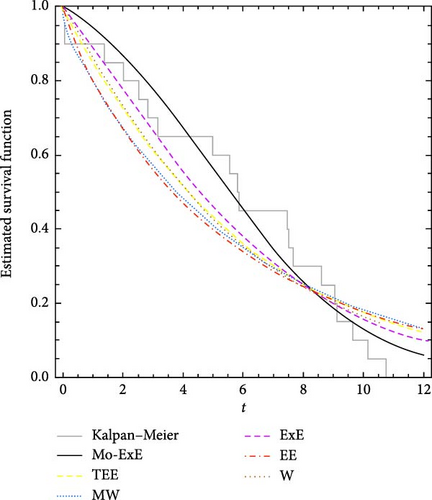
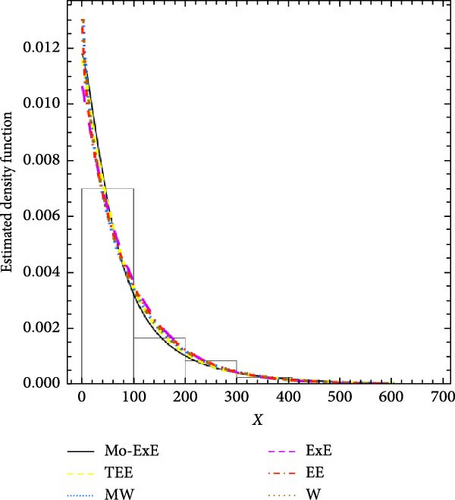

7. Concluding Remarks
In this work, a novel three-parameter life expectancy distribution called the MO-ExE distribution is presented. The new model has a significant amount of data analysis versatility. Numerous mathematical features are examined in this work. The maximum likelihood method is used to estimate the model parameters. To show how the parameter model behaves, a simulation study is assessed. Finally, we show the versatility and potential of the innovative model by investigating real-world data applications, which emphasizes the model’s importance. The limitation of this article lies in the estimation part because we used the MLE method only with complete samples to estimate the parameters of the MO-ExE distribution. This limitation will open the door for researchers to estimate the parameters of the MO-ExE distribution using different estimation approaches using various ranked and censored schemes in future work.
Conflicts of Interest
The authors declare no conflicts of interest.
Funding
This research is supported by the Ongoing Research Funding Program (Grant ORF-2025-548), King Saud University, Riyadh, Saudi Arabia.
Acknowledgments
This research is supported by the Ongoing Research Funding Program (ORF-2025-548), King Saud University, Riyadh, Saudi Arabia.
Open Research
Data Availability Statement
The data that support the findings of this study are available upon request from the corresponding author. The data are not publicly available due to privacy or ethical restrictions.




